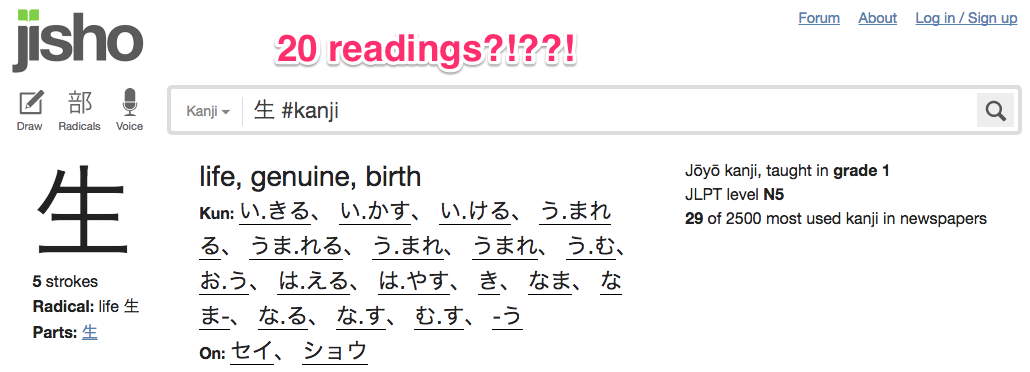Reading and writing Japanese vs. Chinese
Is it harder to learn to read Japanese or Mandarin Chinese? Let’s find out!
When you encounter a character in Mandarin, how many possible readings are there?
Let’s look up a very common character, 生, in a popular Mandarin-English dictionary:
One way to read this character? That seems reasonable.
What about the Japanese reading for the same character, 生, in a popular Japanese-English dictionary?
In what sort of writing system would you use a single character for 20 different readings???
Yes, this character is exceptional, but it’s not rare for characters to have three, four, or more readings in Japanese. Usually each character to has two readings – one derived from the native Japanese reading, and one derived from the Chinese reading (of whatever dialect and time period it happened to be imported).
So, why I am bringing this up now, when I’ve been studying Japanese for more than 15 years?
Well, I just spent a month in Beijing learning Chinese*. And I found that Chinese characters are perfect for writing Chinese. (Shocking that the Chinese developed a system that works for their language, right?) Each character generally has one possible reading.
But using Chinese characters to write Japanese is like this cat trying to squeeze into this box:
Ultimately, some cat/language parts are going to stick out awkwardly (and that’s where okurigana comes in).
Yes, in Mandarin, you have to learn a tone with the reading of each character. But with Japanese, you also have to know whether the vowel sound is long or short, whether consonants are doubled (geminate), and whether the consonant sound changes in combination with other sounds (rendaku). Not to mention pitch accent…
Okay, sure, the Chinese have created some crazy characters, like this one that puts the biāng in my new favorite noodles, biāngbiāngmiàn:
58 strokes of deliciousness!
But not to be outdone, the Japanese went ahead and invented their own “Chinese” character that is even worse! Feast your eyes on taito, an 84-stroke monstrosity:
Just…NO!
So, while learning to read and write in Chinese is definitely a challenge, if you want to really torture yourself, why not give Japanese a try?
Personally, I didn’t know what I was getting into when I started learning Japanese, but it turned out to be one of the best decisions of my life. If you bring on the challenge, you’ll also reap the rewards–whatever language you choose to learn.
So, which language do you think is harder to learn to read?
*Yep, 1 month is not very long, and I reserve the right to change my opinion as I continue learning!





3 Comments
Having only learned Chinese, I still say Japanese is so much harder. This does not mean Chinese is easy — the tones (which most non-native speakers never master), the characters (I can only remember how to write many using a computer) and the putative lack of grammar (which is not entirely accurate), make it difficult enough, and one of the most challenging languages to learn for English speakers. But when I consider the three writing systems and the complex hierarchal nature of Japanese, there is still no comparison. I would still love to learn Japanese, but fear I am now too old to do so. Maybe French, but not Japanese!
BTW, what does that character with three clouds and three dragons (using the Chinese meanings) actually mean?
I didn’t include the meaning because it doesn’t really have one, it would seem! Wikipedia explains that it is really only used as the name of a ramen shop.